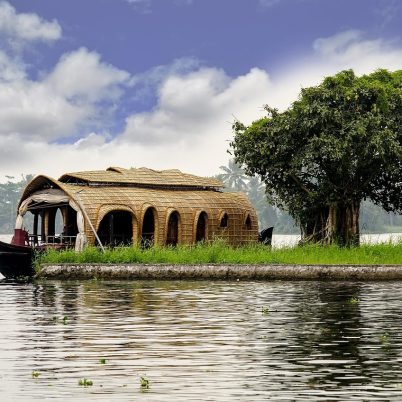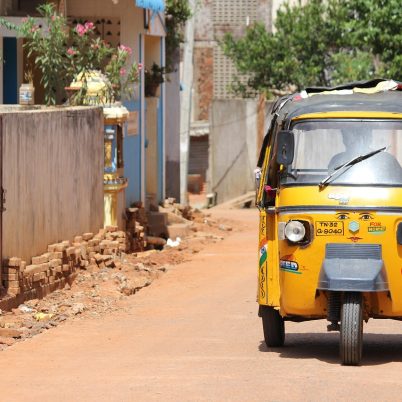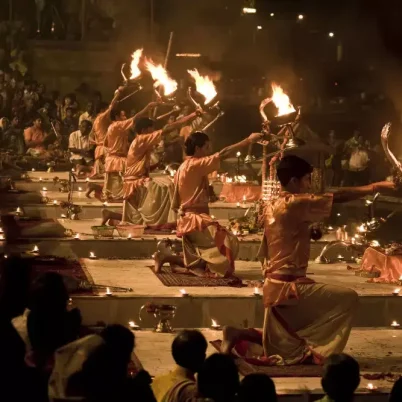
If visiting Kerala in South India is on your travel bucket list, you definitely cannot miss the houseboat experience in the backwaters of Kerala. Called God’s Own Country, Kerala is a paradise for nature lovers, and the Kerala backwaters only enrich the experience. In this blog, we explain the pros and cons of a houseboat experience, give you an overview of the prices, and introduce you to alternatives.
Kerala tourism thrives on its beautiful backwaters. Kerala has a lot of hidden gems to explore, but a Kerala houseboat experience, or at least a day trip or day cruise in the backwaters is something you should not miss. You can visit the backwaters of Munnar and Kochi, rent an Alleppey houseboat, or explore the Vembanad Lake and Kumarakom backwaters. You will fall in love with the stunning scenery, everyday life of the locals, and the slow pace of Kerala’s rural life – it is truly a wonderful experience!
What are the backwaters and what is a houseboat?
A unique network of waterways comprising 29 lakes and lagoons, 44 rivers, and 1500 kilometers of canals and water channels parallel to the Arabian Sea make up the Kerala backwaters in South India. This beautiful ecosystem is home to a variety of flora and fauna and is the highlight on a trip to Kerala.
The backwaters are well-known for their motorized houseboats which allow visitors to take a scenic cruise through the calm waters. Originally, traditional boats called “kettuvallams” were used to transport spices, rice, and other goods through the backwaters. In the local language, “kettu” means “to tie or stitch” and “vallam” means boat. The name refers to the traditional construction method of these unique boats. Even today, the boats are made from anjili wood (wood of the jackfruit tree) and bamboo, and the planks are tied together with coconut or palm fibers – not a single nail is used in its construction! Today, the Kerala houseboats are a modern version of the kettuvallams.
The Kerala houseboat is ideal for a backwater trip for a large group or a romantic getaway. Ideally, you should stay for one or two nights on a Kerala houseboat. Cruise through the Kerala backwater along the paddy fields and coconut groves in the houseboats in Kerala. On the banks of Lake Vembanad, the Kumarakom Bird Sanctuary is located in the backwaters in Kumarakom!
Read: Things to do in Kerala
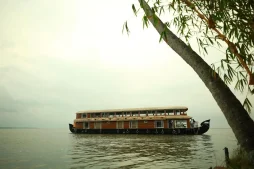
Types of Houseboats
Kerala house boats are usually of two types: one is a private houseboat, which most tourists generally opt for. The duration of the overnight stay is usually 21 hours, one day and one night. During this time, the houseboats cruise in the backwaters only for 2 to 3 hours. The rest of the time they stand still in the water.
Another type is a shared houseboat. In case you have a really low budget but do not want to miss out on the experience of staying in a houseboat, you can share a large houseboat with another couple or family. This is not a very popular option, but it works for a low budget.
A classic houseboat usually has one bedroom for two people. There are also larger boats with two or three bedrooms with air conditioning, en suite bathrooms, living areas, and a dining area. However, the bigger the boat, the fewer canals and lakes it can navigate through, since the entire houseboat cannot fit through many of the narrow waterways due to its size.
You can also choose a luxury houseboat, which goes above and beyond with added amenities like a rooftop terrace, more lavish meals, and more luxurious rooms! The cost of luxury Kerala houseboats for a day can range from INR 5000 to INR 1,00,000 or more, depending on the added luxuries.
Rules for houseboats in the backwaters
The rise in backwater tourism has led to a rise in the number of Kerala houseboats in South India in recent years. Many new houseboat companies have started in recent years. This is not necessarily good news for the environment, which is why there are strict rules and regulations in place. The number of boats has been limited. A new houseboat is allowed only if an old one is retired. Plus, there are fixed places where a houseboat can travel and where it can be docked. These restrictions aim to protect the natural ecosystem and curb the increasing environmental pollution caused by the motorized boats.
See also: Best time to visit Kerala
What to expect from a houseboat experience
- A houseboat cruise in the tranquil backwaters of Kerala is a beautiful experience, but your plan should depend mainly on your travel schedule during the stay and the number of travelers.
- A typical houseboat stay lasts for 21 hours, with check-in at noon and checkout between 9 and 10 a.m. the next day. If you arrive late on the day of check-in or need to leave early the next morning, the houseboat stay may not be worth it as you wouldn’t get enough time to experience it properly.
- Once you are aboard, you cruise through the canals and lakes for around 3 hours before docking at a lake or a small island where you spend the night.
- There will always be a boatman and caretaker on board to ensure safety and comfort. The delicious meal served on the boat includes authentic South Indian specialities, fresh fish and seafood, and fruits throughout the stay.
- A houseboat has space for lying down and relaxing so that you can enjoy the backwaters in peace. Sometimes, you can dock at an island and explore the region on foot as well.
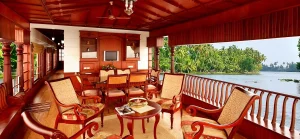 Rooftop terrace
Rooftop terrace
Things to keep in mind
- You might have seen pictures of a secluded house boat floating on the Kerala backwaters, but that is not always the case in reality. Staying on a houseboat in Kerala is a popular attraction, and you may see many other houseboats full of tourists cruising along the same path as yours.
- As a popular bucket list item, Kerala houseboats tend to get booked weeks in advance during peak season, so make sure to book your house boat beforehand.
- Water bodies with lush greenery around are often breeding grounds for mosquitoes. Kerala’s backwaters too are filled with mosquitoes, so make sure to carry a mosquito repellent spray or coil with you, even if you are on the most luxurious houseboat in Kerala.
- Notify the boat operators beforehand that you will need an English speaking chef and caretaker, since the native language of Kerala, Malayalam, can be really hard to understand.
- Kerala is a primarily non-vegetarian state, so if you want vegetarian meals, make sure to tell the onboard chef or caretakers beforehand.
Reasons to avoid a houseboat experience
- Kerala houseboats offer a peaceful experience, but you don’t really get much insight into life in the backwaters. Plus, there are strict restrictions on where houseboats can travel and dock. You won’t get too close to any wildlife, local culture, and natural landscape of Kerala’s backwaters. Living on water can also feel slightly isolated.
- We usually do not recommend houseboats for solo travelers, as the experience, although relaxing, can get lonely. The Kerala houseboat experience is ideal for 2 to 4 people.
- Another important aspect is the environmental impact. Motorized houseboats require fuel and produce emissions that cause a lot of noise and water pollution, affecting the fragile backwaters ecosystem. It also disturbs the local wildlife.
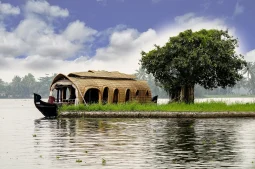
Alternatives to houseboats in the Kerala Backwaters
- You don’t have to stay in a Kerala houseboat to get a truly immersive experience of the Kerala backwaters. You can stay in a good hotel or other amazing accommodations and homestays that allow you to truly experience the local life of Kerala. You will get delicious,authentic meals and a taste of everyday life. You might also meet other travelers during your stay.
- Some accommodations are located on private islands in the backwaters, complete with all the necessary amenities, such as the gorgeous Riverdale resort. On the other hand, you can stay at the many homestays in the region and enjoy authentic food and delicious meals, immerse yourself in the daily local routine, and support the community sustainably.
- In such accommodations, you can explore on foot or rent bicycles and go for small day trips along the backwaters. You can also rent a canoe and explore the backwaters. A canoe ride allows you to navigate the narrow canals and experience nature a lot more closely.
- Instead of the popularized Kerala houseboat, you can also take a boat trip in the backwater on one of the smaller non-motorized kettuvallams, shikara boats, rowing boats, or the tourist ferry.
Read more: Best places to visit in Kerala
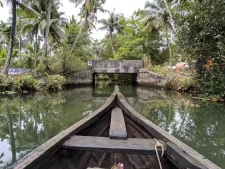 Canoe ride
Canoe ride
We hope this blog helps you make an informed decision about whether or not to choose a houseboat in the Backwaters of Kerala! Regardless of your choice, we, at India Someday, are here to plan the perfect trip for you, tailored to your preferences! For further details, do contact us and we will customize your ideal trip!
Frequently Asked Questions
Yes, the houseboat experience in Kerala is something worth trying if you are ever in the state. You get to see the local life of the villages that are dependent on the water from these canals for their day-to-day lives. It also takes you right in the lap of nature as you float around the backwaters.
Yes, houseboats in Kerala are safe even at night. The crew of the boat is always at hand in case you need something, while also offering complete privacy. The boats are also equipped with safety measures like a fire extinguisher and life jackets.
You can enjoy a day trip in a houseboat that lasts for 5 to 6 hours, or you can opt for an overnight stay.
The climate of Kerala is tropical, so wear light, breathable clothes. Carry a shawl or light jacket for the cooler evenings in the water.
helping you travel your way
Everything you need to know about India is here We have tried writing about everything you may need help with for your trip to India, If you need help in planning a trip to India Get in touch with us to to plan your trip of a life time.





